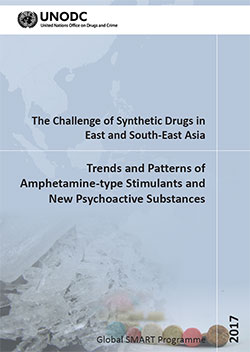
Bangkok (Thailand), 1 June 2017 - Potent synthetic drugs manufactured in East and South-East Asia¸ including fentanyl and new fentanyl analogues, are impacting drug users in different parts of the world including North America where they are contributing to an epidemic of overdose deaths. These highly toxic substances, some of which are present in small doses in pain medication, can be manufactured in clandestine laboratories in the region and shipped by mail to North America to be sold in the heroin market or as counterfeit painkiller pills.
A growing number of these synthetic drugs, also referred to as new psychoactive substances, are being identified in the region with 168 identified to date. The drug overdose epidemic shows how quickly new drugs can have a significant harmful impact in the drug market and on users.
A number of new psychoactive substances have already found their way into the "ecstasy" market in East and South-East Asia where they are sold in pill form as fake "ecstasy" and under a range of different street names.
"Although the use of new psychoactive substances by drug users in the region is still limited compared to methamphetamine, the region is frequently mentioned as the origin of shipments trafficked to other regions", said Mr. Martin Raithelhuber, Illicit Synthetic Drugs Expert with UNODC. "There is a high risk of these substances gaining a stronger foothold in the region. Limited forensic capacity to detect and identify these new drugs, coupled with limited knowledge about health risks mean that they may remain undetected for a considerable length of time", Mr. Raithelhuber added.
 East and South-East Asia is known for its growing market for methamphetamine and a sizeable heroin market. Preliminary figures for 2016 indicate that seizures of pill and crystal methamphetamine will exceed 2015 and again reach another historic level. While seizures and use of methamphetamine have been rising for many years in the region, the emergence of new psychoactive substances has created a more complex drug situation for national authorities to manage. "Current methods of drug detection and identification are useful for drugs such as methamphetamine, and more and more methamphetamine is actually seized by law enforcement authorities, but they don't necessarily work for new psychoactive substances", explained Mr. Inshik Sim, Information Analyst for UNODC in Bangkok.
East and South-East Asia is known for its growing market for methamphetamine and a sizeable heroin market. Preliminary figures for 2016 indicate that seizures of pill and crystal methamphetamine will exceed 2015 and again reach another historic level. While seizures and use of methamphetamine have been rising for many years in the region, the emergence of new psychoactive substances has created a more complex drug situation for national authorities to manage. "Current methods of drug detection and identification are useful for drugs such as methamphetamine, and more and more methamphetamine is actually seized by law enforcement authorities, but they don't necessarily work for new psychoactive substances", explained Mr. Inshik Sim, Information Analyst for UNODC in Bangkok.
In response to the increasing number of new psychoactive substances in the region, UNODC has established an Early Warning Advisory on New Psychoactive Substances. The Advisory tracks new drug trends and informs national authorities and experts about emerging drugs and risks associated with them.
The United Nations has reacted to the emergence of highly dangerous new drugs by recently placing 27 substances under international control, including 10 substances in March of this year. This allows countries to prevent the export and import of these drugs and collaborate to prevent trafficking. However, many countries in the region are still not in a position to detect and identify newly listed drugs and may not be ready to implement related controls. "There is a risk that organized crime and traffickers will exploit vulnerabilities and loopholes created by uneven national technical capabilities and legal landscapes", said UNODC's Regional Representative, Jeremy Douglas.
UNODC works closely with countries in the region to identify drug trends and provide expert advice on detection, investigation and health responses, and importantly to create space for countries to collaborate and respond together. "A coordinated approach to the emergence of new drugs would go a long way to address the challenge while it is still relatively manageable", added Mr. Douglas.
Click here to learn more about UNODC's work on Drugs and precursors.
Click here to learn more about the UNODC Global SMART (Synthetics Monitoring: Analyses, Reporting and Trends) Programme.
Click here to learn more about the Asia and Pacific Amphetamine-Type Stimulants Information Centre.